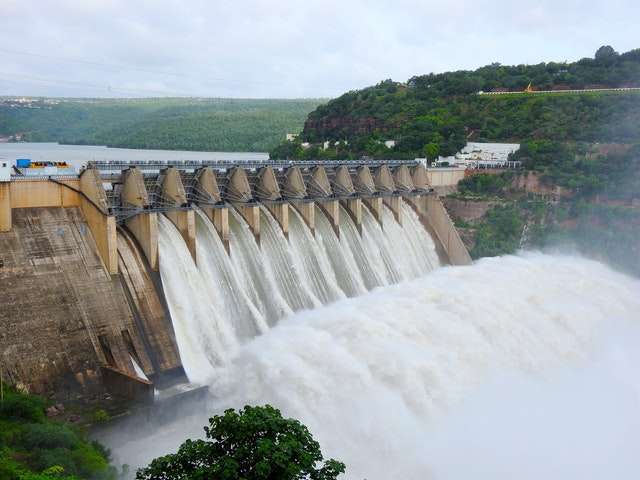Alternative energy refers to energy sources other than coal, petroleum, and diesel and also includes all renewable and nuclear energy sources. Alternative sources of energy are solar power, wind power, geothermal, biomass, hydro power, waste energy and so on. These renewable energy sources are not polluting the environment and they help to reduce the level of greenhouse gas emissions in the atmosphere.
Alternative energy sources have a much lower carbon footprint than natural gas, coal, and other fossil fuels. Switching to renewable energy sources to produce electricity will help the planet by slowing and reversing climate change. The alternative energies that are already being used are solar, wind, geothermal, hydroelectric, tidal, biomass and hydrogen.
There are 2 types of Sources of Energy. These can be broken down into renewable and non-renewable energy sources.
Renewable Energy Source
A renewable energy source is a natural resource. These can replace it quickly and dependably. Energy sources are plentiful, sustainable, naturally replenished and good to the environment.

The major types or sources of renewable energy are:
- Solar energy from the sun:
- Wind energy
- Geothermal energy from the heat inside the earth
- Hydro power from flowing water
- Ocean energy in the form of wave, tidal, current energy and ocean thermal energy.
- Biomass from plants
1. Solar Energy
The primary source of energy is the sun and it harvests the energy by using collector panels to create conditions that can then be turned into a kind of power. These are often used in the desert to gather enough power to charge small substations, and many homes use solar systems to provide for hot water, cooling and supplement their electricity.
Its availability is also dependent on the change in seasons and weather when they may not always be used. It requires high initial investments for productive use as solar electricity storage technology.
2. Wind Energy
Wind power is becoming more and more common. By using large turbines to take available wind as the power to turn, the turbine can then turn a generator to produce electricity.
It requires high investment, and wind speed is also not uniform every time, which affects the generation of power.
3. Geothermal Energy
Geothermal energy is the energy that is produced from beneath the earth. It is clean, sustainable and environmentally friendly. Hot rocks present below the earth heats up the water that produces steam. The steam is then captured, which helps to move turbines. The rotating turbines then power the generators.
Geothermal energy can be used by a residential unit or on a large scale by an industrial application. It was used during ancient times for bathing and space heating.
Another disadvantage is, where there are no underground reservoirs, creating geothermal plants may increase the risk of an earthquake in areas already considered geological hot spots.
4. Hydrogen Energy
Hydrogen is available with water (H2O) and is the most common element available on earth. Water contains two-thirds of hydrogen and can be found in combination with other elements.
Once it is separated, it can be used as a fuel for generating electricity. Hydrogen is a tremendous source of energy. It can be used as a source of fuel to power ships, vehicles, homes, industries and rockets. It is completely renewable, can be produced on demand and does not leave any toxic emissions in the atmosphere.
5. Tidal Energy
Tidal energy uses the rise and fall of tides to convert the kinetic energy of incoming and outgoing tides into electrical energy. Tidal energy is one of the renewable sources of energy and produces large energy even when the tides are at low speed.
6. Wave Energy
Wave energy is produced from the waves that are produced in the oceans. Different techniques for transforming wave energy to electric power have been studied with dam-like structures or ocean floor–anchored devices on or just below the water’s surface. Wave energy is renewable, environment friendly and causes no harm to the atmosphere.
7. Hydroelectric Energy
The power of the water is used to turn generators to produce the electricity that is then used. It is non-polluting, entails no waste or produces toxic gases, and is environmentally friendly.
8. Biomass Energy
Biomass energy is produced from organic material and is commonly used throughout the world. Chlorophyll present in plants captures the sun’s energy by converting carbon dioxide from the air and water from the ground into carbohydrates through the process of photosynthesis. When the plants are burned, the water and carbon dioxide are again released back into the atmosphere.
Biomass generally includes crops, plants, trees, yard clippings, wood chips and animal wastes. Biomass energy is used for heating and cooking in homes and as a fuel in industrial production.
Non-renewable Energy Source
A non-renewable energy source is a source with a limited supply. These are extracted from the earth, and it’ll eventually run out.
These are formed over thousands of years from the buried remains of ancient sea plants and animals that lived millions of years ago. Most of these energy sources are “dirty” fossil fuels, which are generally bad for the environment.
The major types or sources of non-renewable energy are:
- Petroleum
- Hydrocarbon gas liquids
- Natural gas
- Coal
- Nuclear energy
How to use energy resourcefully in your daily life?
- Start using Solar Powered Lights.
- Try powering Homes with Solar and Wind Power.
- Make use of Bio ethanol to Power Cars, Solar Powered Cars.
- Avoid Heating the Home Unnecessarily.
- Don’t Use the Tumble Dryer.
Residential uses of energy
These are the most basic uses of energy. They include watching television, washing clothes, heating and lighting the home, taking a shower, working from home on your laptop or computer, running appliances and cooking. Residential uses of energy account for almost forty percent of total energy use globally.
Commercial uses of energy
Commercial use of energy is used in the commercial sector. This includes heating, cooling and lighting of commercial buildings and spaces, power used by companies and business throughout our cities for computers, fax machines, workstations, copiers just to name but a few.
Energy saving here though, is targeted at the corporate world rather than at individuals.
Transportation
Transportation is 100% dependent on energy. Over seventy percent of petroleum used goes into the transport sector. The transport sector includes all vehicles from personal cars to trucks to buses and motorcycles. It also includes air crafts, trains, ships and pipelines.
Innovations such as the introduction of more fuel efficient vehicles and development of alternative sources of energy for our transport system can greatly help in the saving of energy.
The main advantage of these alternative energy sources is that they are ecologically acceptable energy sources that, unlike fossil fuels, do not release large quantities of CO2 and other harmful greenhouse gases into the atmosphere, causing global warming and climate change. Therefore it is imperative that energy should be used thoughtfully and carefully.
